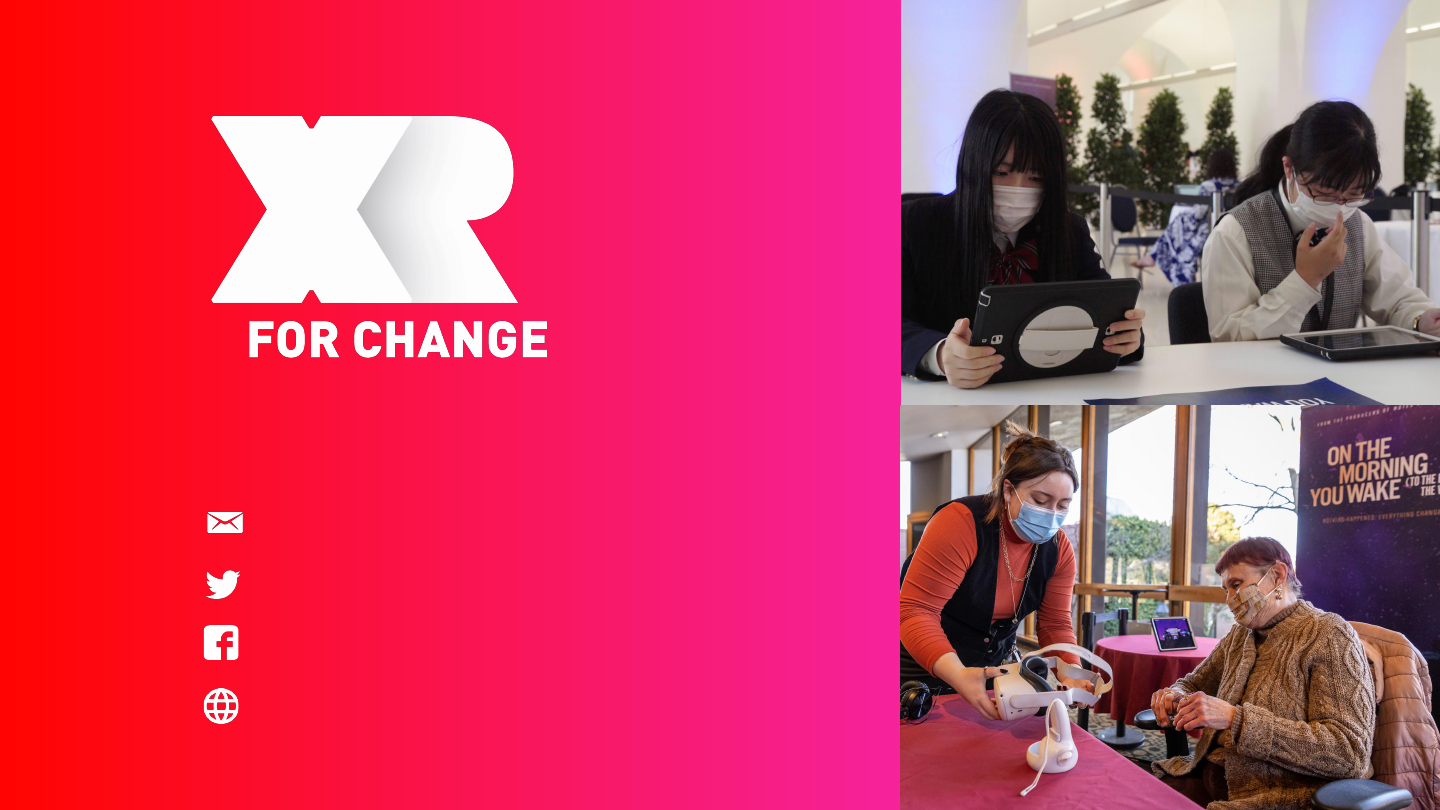
Field Guide
Best Practices for Producing a VR Activation
gamesforchange.org/XR4C
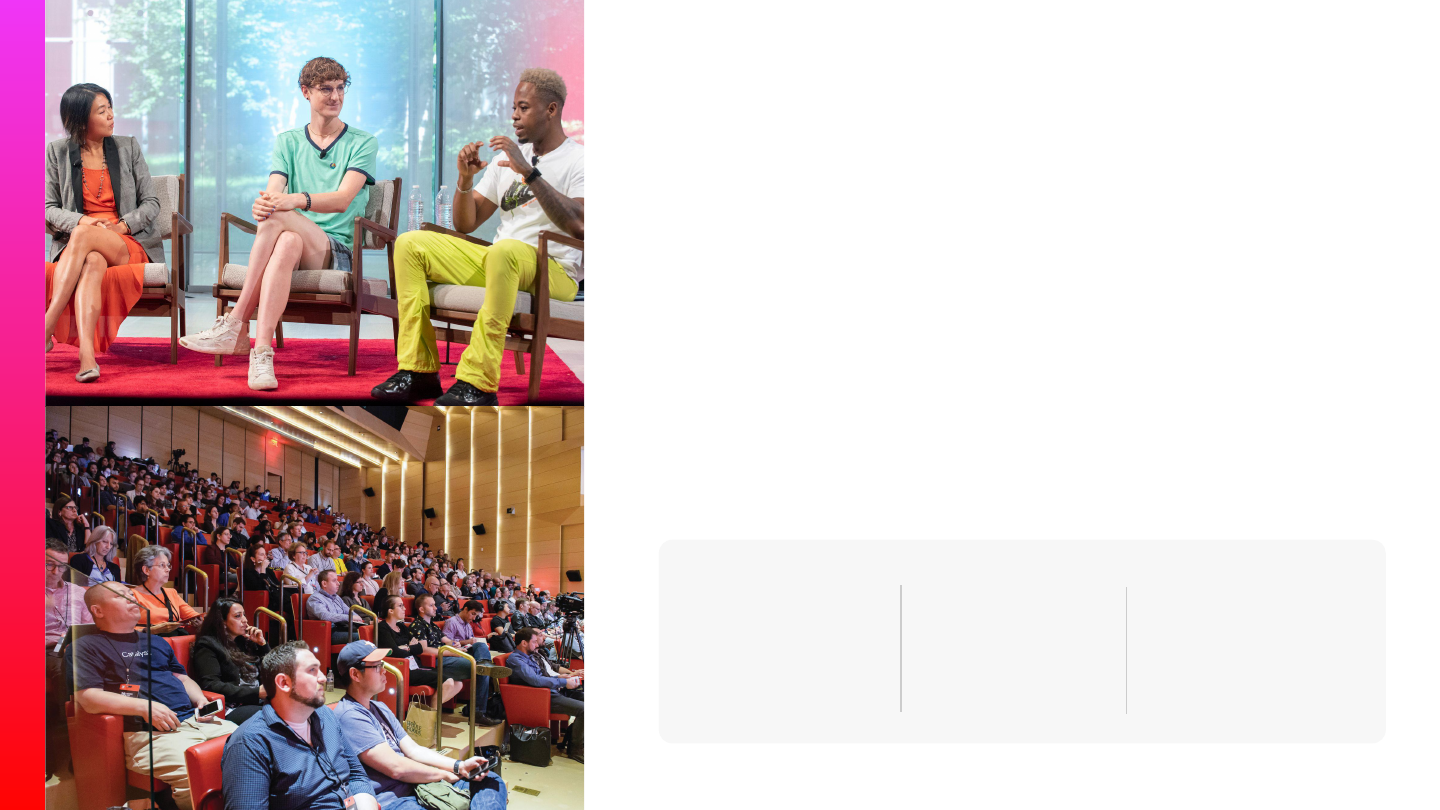
About Games for Change
Games for Change (G4C) leads a global community of creators,
developers, and innovators using games and immersive media to
empower their communities and drive real-world change. It partners
with technology and gaming companies, nonprofits, foundations,
academic institutions, and government agencies to run a wide array of
programming, from world-class events and educational programs, to
executive production and impact productions of best in-class games
and XR projects.
Engaging with
127
Countries
Events
5K+
Attendees per year
Programs Impacting
25K+
People per year
Games for Change is a registered 501c3 organization.

About XR for Change
Launched by Games for Change in 2017, XR for Change (XR4C) is
developing a community of practice to address real-world challenges,
create empathy, and drive social change using Augmented Reality (AR),
Mixed Reality (MR), and Virtual Reality (VR).
There is a wide range of practical applications for XR technologies
invested in social impact — particularly in education, healthcare and
mental health, and workforce development.
The initiative seeks to encourage dialogue; foster collaboration
between content creators, industry, and cause-based organizations;
advance equity and inclusion; and inspire creative use of these
emerging technologies.
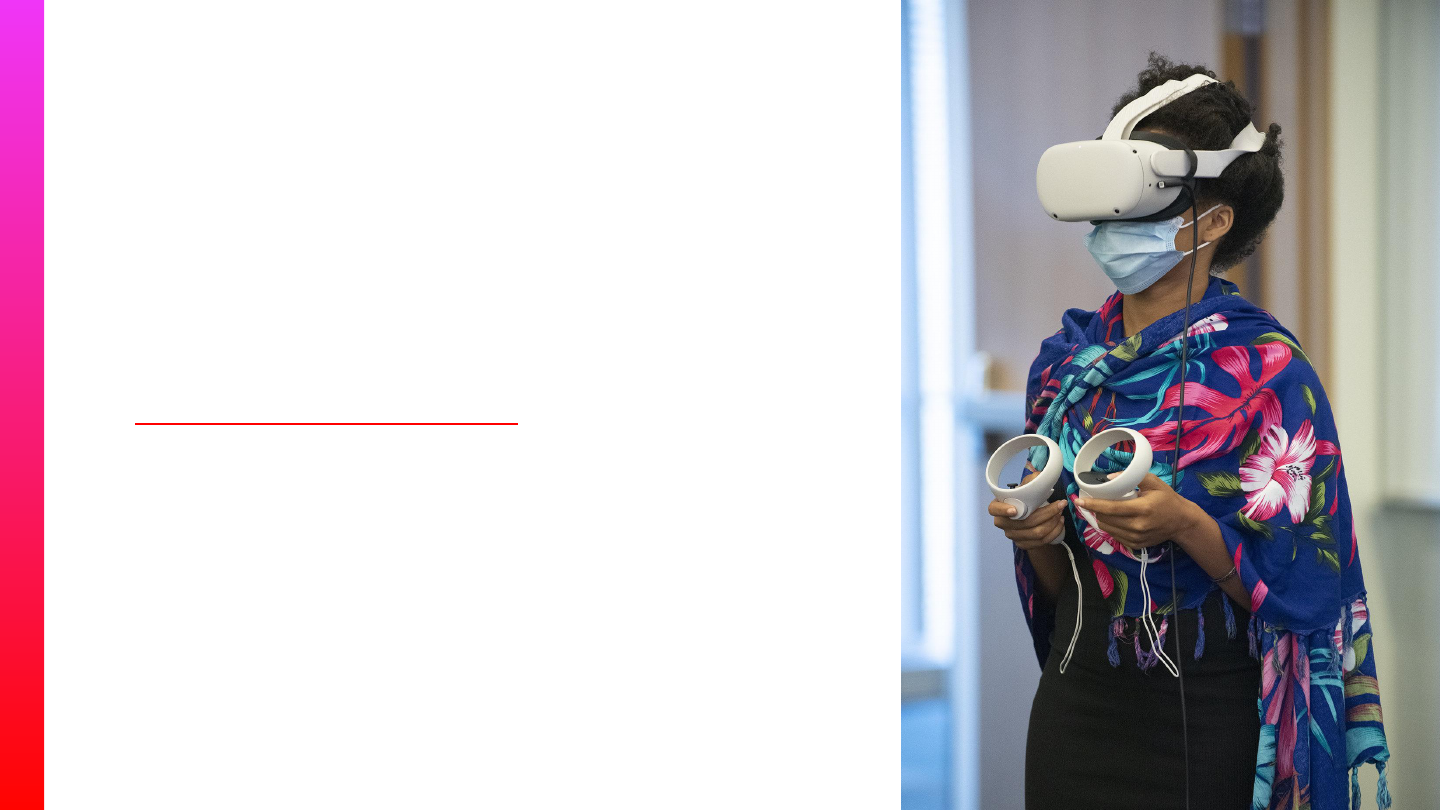
4
Field Guide Overview
This field guide was created to capture the learnings from
over 20 impact campaigns produced for the VR experience
On The Morning You Wake (OTMYW).
Our hope is that the findings in this guide help producers
employ best practices when creating similar impact
campaigns with a focus on audience learning, impact, and
engagement.

5
Types of HMDs
Different types of head-mounted displays (HMDs) can be
considered for events:
1. Standalone/Untethered: Self-contained VR headsets that are
portable, powered by internal batteries, and use built-in
processors (often based on mobile devices such as Android).
No computer is required to operate.
2. Tethered: VR headsets that are connected to a VR-capable
computer via cables or Wi-Fi. There is no on-board computing.
They act purely as a HMD. Eventually these could be fully
powered by edge computing solutions over 5G or 6G cellular
networks.
3. Hybrid: Some VR headsets have processing and storage
capabilities but also allow input from external devices.
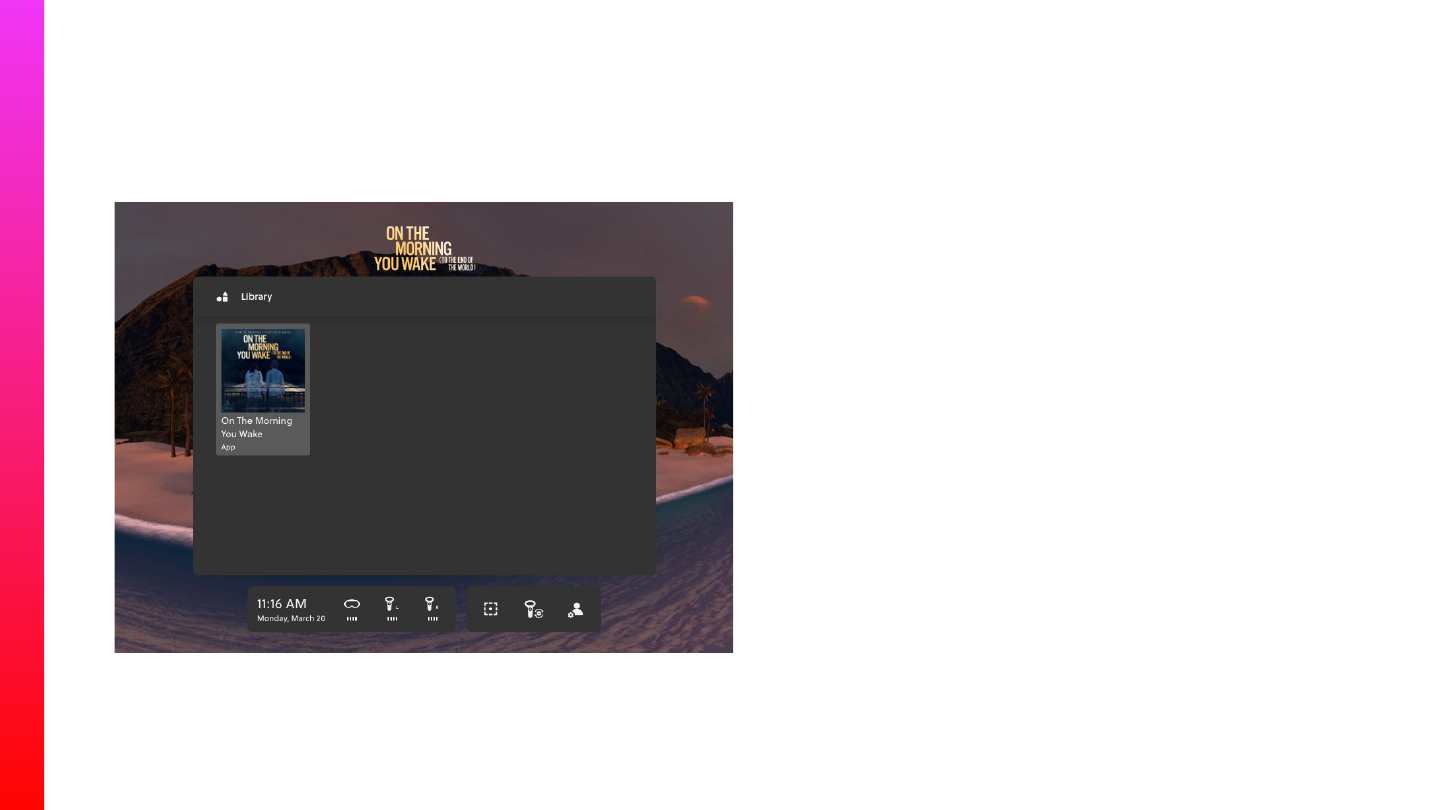
6
A challenge in scaling to multiple VR activations is
the number of devices that need to be maintained.
Device Management System: While most headsets
require individual account information and
purchasing of in-store apps, some companies offer
solutions for managing multiple VR headsets that
include but are not limited to:
● Account syncing;
● Side-loading;
● Customized home screens;
● Remote management;
● Lockdown capabilities for multiple VR headsets;
● Streaming the content inside of the VR headset
onto a mobile device like a tablet or cellphone.
VR Headset Fleet Care
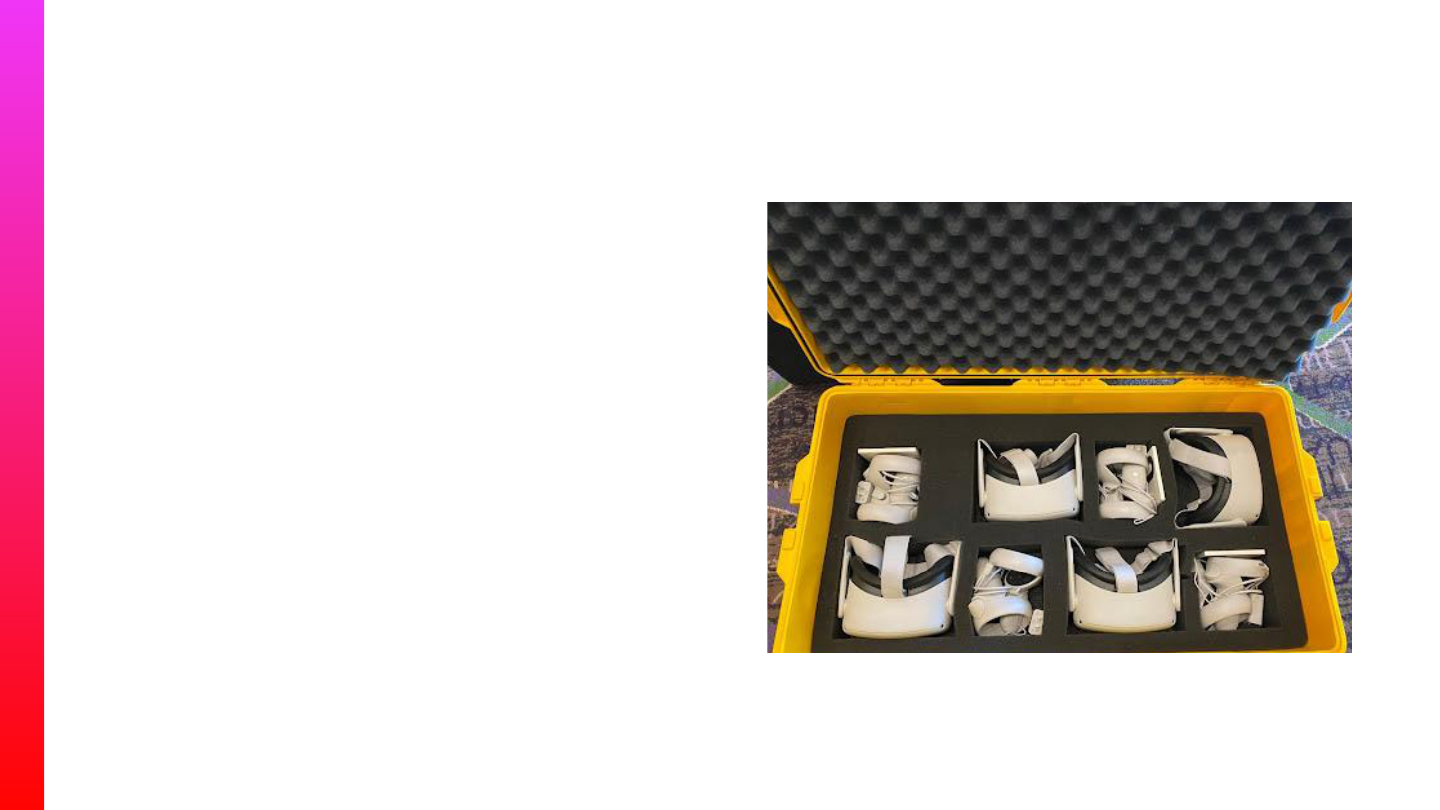
7
We recommend using sturdy plastic cases that are
available in various sizes with internal padding and
separators. Different models also offer wheels for
rolling heavier cases.
Always do a quality control check before and after
any activation to troubleshoot any issues before the
next activation:
● Check battery levels
● Check your headphone wires
● Check how many wipes and batteries you have left
Hide a small tracking device within your Pelican when
shipping, so you aren’t relying on tracking numbers as
your sole connection to your VR kit.
● The XR4C Impact Team uses Apple’s AirTags for
this purpose.
VR Headset Fleet Management

8
Transportation
For the OTMYW impact campaign, VR kits were
created to support activations in various locations
around the world which requires shipping all the
necessary equipment between viewings. For example,
a checklist of essential items for all types of VR
activations was created.
Checklist For VR Event Kits
● VR HMDs
● Controllers
● Chargers with cables
● Surge protectors
● Tablet devices
● Noise canceling headphones
● Disinfectant wipes
● Microfiber cloth(s)
● Promotional materials
○ Postcards, pop-up banners, QR codes etc.
● Production hard case that rolls
● Tracking device

9
Onboarding a
Participant to VR
VR onboarding is the process of familiarizing participants to VR and
preparing them for what to expect before they put on the headset.
The experience is very similar if a participant is experienced with VR
or if it’s their first time. Their onboarding is complete when:
● They know how this specific experience will work.
● Their headphones are fully situated on both ears.
● Their controllers are held in both hands.
● They are not raising their hand for assistance.
The extra time spent ensuring a strong onboarding will increase your
chances of participants having a pleasant experience and them
encountering less interruptions due to technical issues.
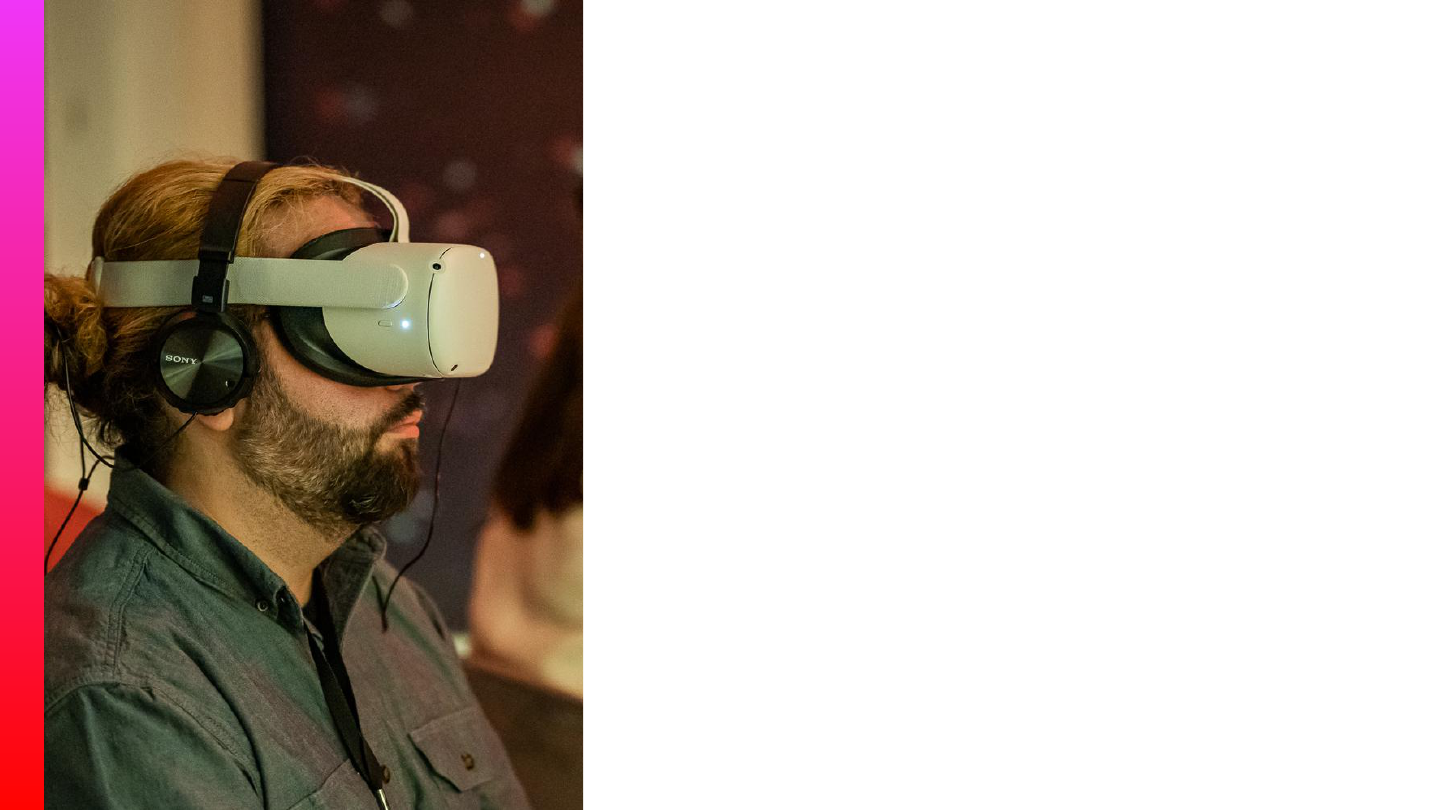
1
0
Phases & Timeline
of an VR Activation
G4C staff usually breaks a VR activation down into four phases:
● Partnership Discussion: creating a relationship with a venue,
event, or organization to host the VR activation
● Pre-Production: preparation leading up to the VR activation
● Production: loading in and prepping equipment at the venue as
well as managing the VR activation itself
● Post-Production: wrapping up tasks once the VR activation is
completed
A VR Activation timeline can be anywhere between 2-6 months
depending on the scale of the activations and scope of the
partnerships. Here’s a breakdown of those timelines:
● Open to the Public Screenings: 1-4 months
● Museum Exhibitions: 4-6 months
● Private Events Screenings: 1-3 months

1
1
Checklist for VR Activation Production
Partnership Discussion:
● Discussion on the feasibility of working alongside the impact team to produce a VR
activation
● Details and responsibilities of all parties are outlined within a partnership
agreements
Pre-Production:
● Certificate of Insurance for on-site team & equipment
● Create a floorplan of how the VR activation equipment and furniture will be laid out
● Tailor wrap-around materials to the event, location, region, or partner
● Curate event specific digital assets
● Layout a marketing, outreach, and PR strategy around the VR activation
● Set up a booking system (if needed)
● VR headset set-up/check
● Ship equipment and marketing assets to venue (if needed)
● Hire local staff to support the VR Activation
● Hire Photographer/Videographer to document the VR Activation
● Create a Run of Show or call sheet for each day of the VR activation

1
2
Checklist for VR Activation Production
Production:
● Load equipment into the venue
● Set up equipment and furniture in the venue
● Train staff to help run the XR activation
● Handle fabrication/painting/ construction of venue or exhibition
(if needed)
● Execute marketing, outreach, and PR strategy
Post-Production:
● Ship equipment and marketing assets back to office (if needed)
● Fulfill Invoices
● Wrap up budget/finances
● Complete documentation
● Recap deck, recap video, recap photos
● Complete marketing/outreach strategy
● Quality check headsets and equipment

1
4
Pre-Production
● Booking System
○ This is for the overall experience of your audience members as
well as a management method for your VR Activations staff to
control demand and traffic flow.
○ Walk-ups are still welcome when a booking system is in use.
○ XR4C-recommended booking system: Waitwhile (Link to demo).

1
5
Pre-Production
● Run of Show
○ A call sheet that lets the ground staff, partners, and
photographers / filmmakers know and understand the
schedule for each day of the activation.
○ It includes but is not limited to: call times, locations, lunch
breaks, tasks, audience screening times, wrap times, and
travel time (if needed).
○ Link to example of OTMYWs run of show
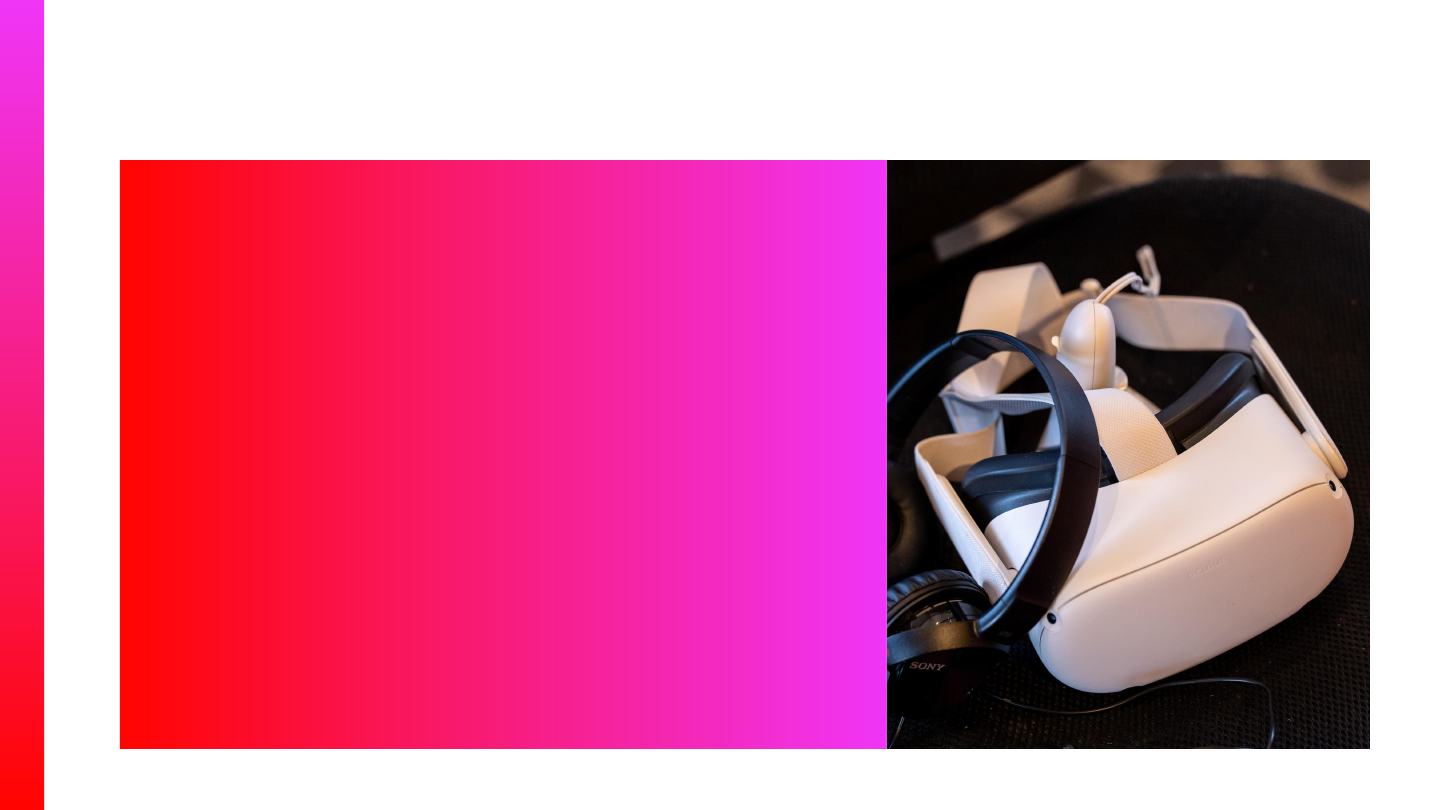
1
6
Checklist For VR Activation Setup
● Experience Signage
● Check-in area for audience members
● Waiting area for audience members who have checked in
● VR screening stations
● Includes ready to screen headsets, controllers, and
headphones
● Area for wrap-around materials
● Can be broken up into two areas to delineate onboarding
and aftercare
● Device charging area
● Lighting check
● Staff training
Production

1
7
Training your VR activation staff is an essential step
in ensuring a successful activation, especially if your
staff has never worked in virtual reality.
● Teach them how to operate and troubleshoot the
VR headsets used in the VR Activation
● A site walkthrough of the VR Activation is useful
for staff to understand the flow of visitor traffic.
The end goal of training is to get the staff to embrace
the values of the impact team and empowering them
to troubleshoot, so they can facilitate the experience
as an extension of the impact team.
Staff Training

1
8
Number of Staff
The number of audience members to activation staff depends on:
● Size of the activation space
● Duration of the VR experience
● Level of interactivity of the VR experience
● The wrap-around materials
Tethered (desktop-based) HMDs usually requires one staff per headset.
For tetherless (stand alone) HMDs, G4C impact staff recommends one
activation staff for every four participants in standalone headsets.
Staff are also assigned to different tasks, such as facilitating wrap-around
materials, checking people in, or disinfecting headsets.
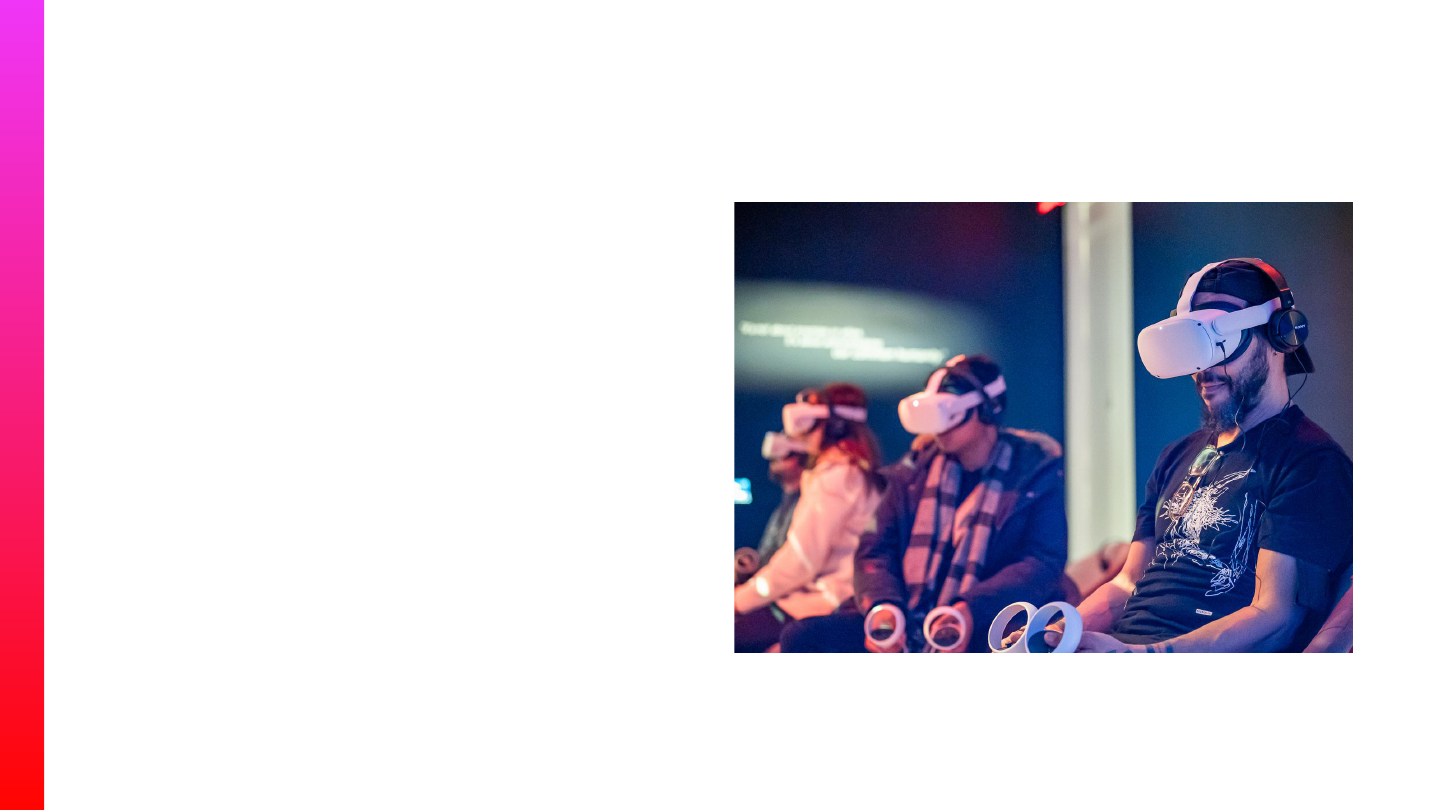
1
9
If you are trying to optimize the amount of headsets
to staff members, utilize a waterfall-style of
screening scheduling.
This allows:
● Only 2-4 audience members to arrive to screen the
VR experience at the same time.
● Five minutes of reset time to clean and reset the
headsets in between each screenings.
● For flexible responses to specific situations which
VR activations often require.
Optimizing Staff

2
0
Museum Exhibitions
In 2022, the G4C Team produced two museum activations.
The activations ran for around one month each.
International museum exhibition at the Nobel Peace Center
in Oslo, Norway
● A single space primarily dedicated to the VR screening
with an extended aftercare space
● VR Screening was free with museum admission
● Showcased the 20-minute VR experience (Chapter 1 Only)
to patrons and field trips
● Capacity of twenty people in the VR screening area
● Three-to-four dedicated staff members to manage the VR
activation

2
1
Museum Exhibitions Cont.
Exhibition at the Museum of the Moving Image (MoMI)
● The installation was separated into two distinct spaces:
○ One dedicated to the production, creative, and impact process
of OTMYW ( this area was free with museum admission).
○ Another one, a gallery space dedicated to screenings of the
full 45-minute VR experience (Chapters 1-3). The VR screening
and this area was an additional ticket to purchase
● Showcased the 20-minute VR experience (Chapter 1 Only) to
field trips
● Capacity for only eight people in the VR screening area
● Two dedicated staff members to manage the VR activation
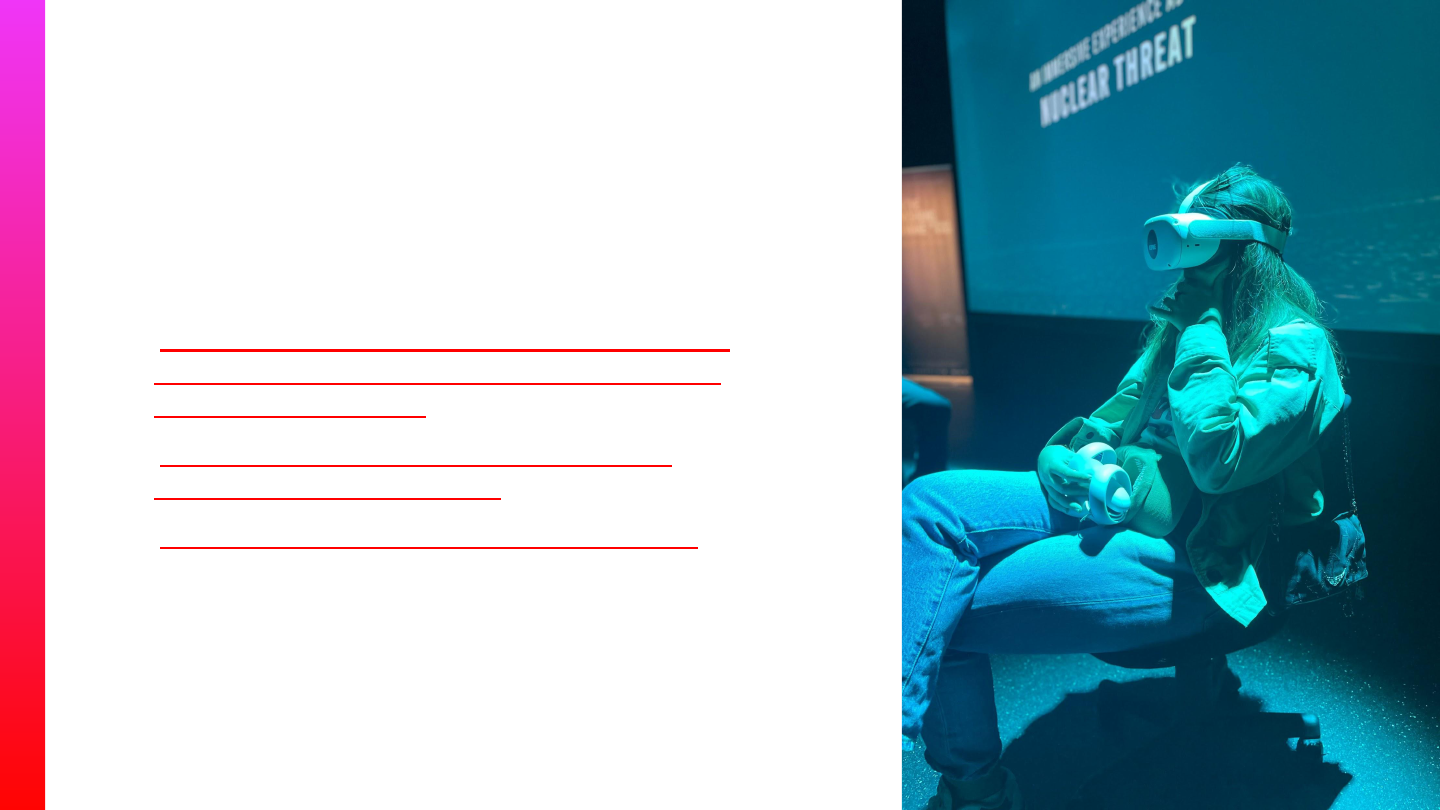
2
2
Learn More
We invite you to explore supplemental resources:
● The Full White Paper this presentation is based off of:
Deepening Engagement and Learning Impact through
Virtual Reality Activations
● Impact Report: Results of Impact & Engagement
Research and Comparison Study
● 2020 XR4C for Social Impact: A Landscape Review

